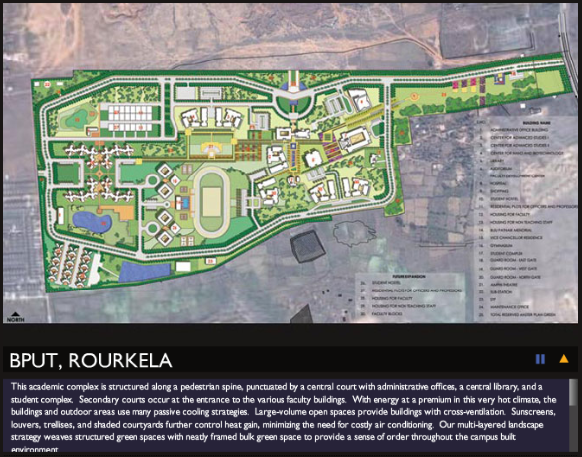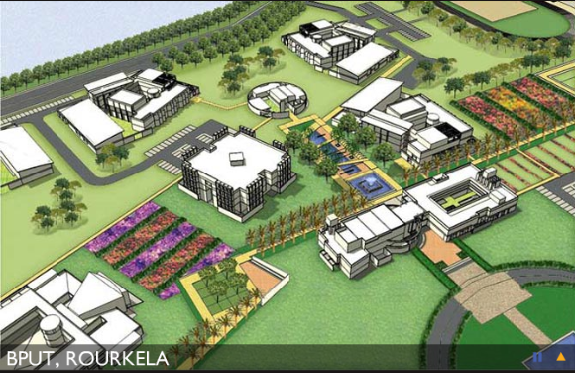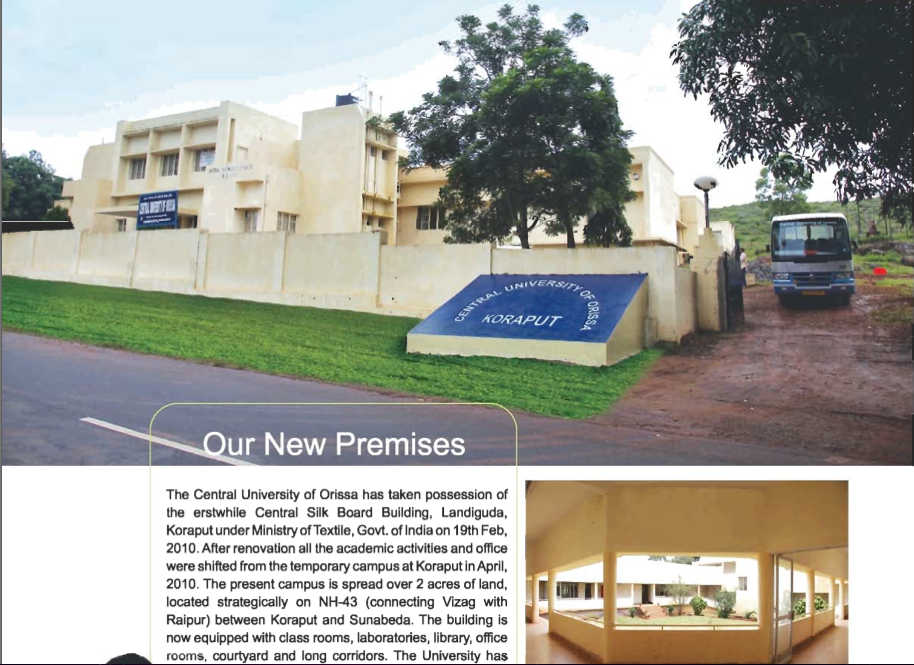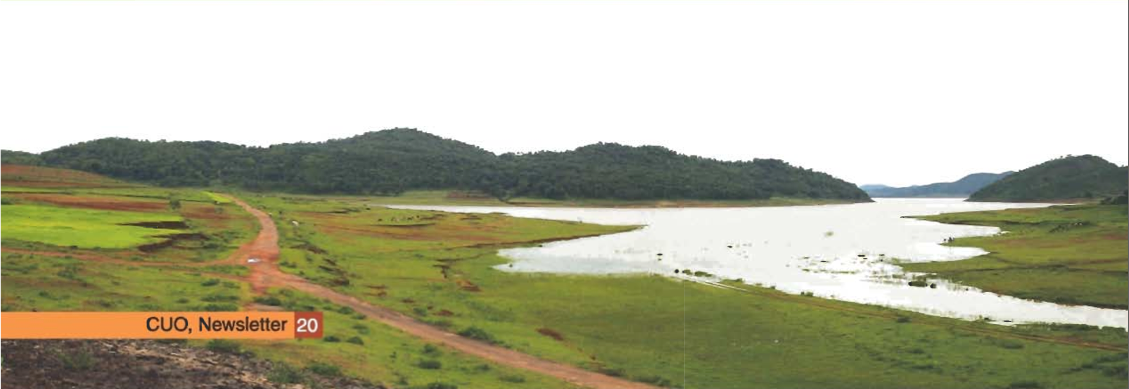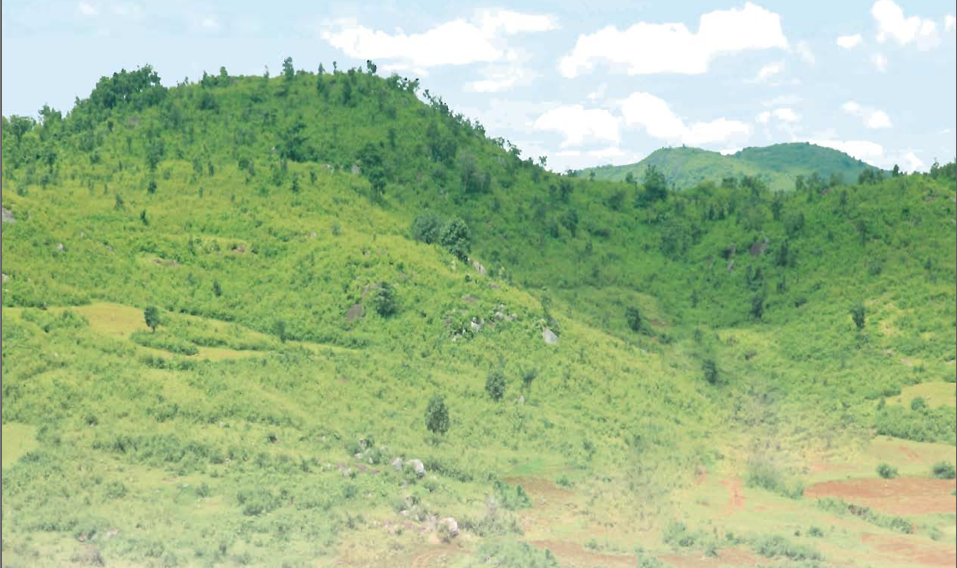Below is a collage of the logos of national level institutes and universities of Odisha. (IIIT is trying to get there.) Note that except NIT Rourkela, which started as an REC in 1961 and became NIT in 2002, the rest have been established in the last 5 years:
- IIIT and NISER in 2007,
- IIT in 2008, NLUO in 2008-9,
- CUO Koraput in 2009, and
- AIIMS in 2012.
See https://www.orissalinks.com/archives/6243 for a timeline of the establishment of various higher educational institutions of Odisha.

See our collection of logos of Odisha higher education institutions and universities in facebook at here and here.
September 2nd, 2012
Following is an excerpt from Priya Abraham’s report in Telegraph.
The Biju Patnaik University of Technology (BPUT) plans to collaborate with the Pune-based Centre for Development of Advanced Computing (C-DAC) to work on various key areas of high performance computing, the use of supercomputers and computer clusters to solve advanced computing problems.
The university is working on setting up five advanced centres of computing in various institutions in the state and intends to set up a high performance computing cluster in their upcoming campus in Rourkela.
February 22nd, 2012
Following is from Samaja.
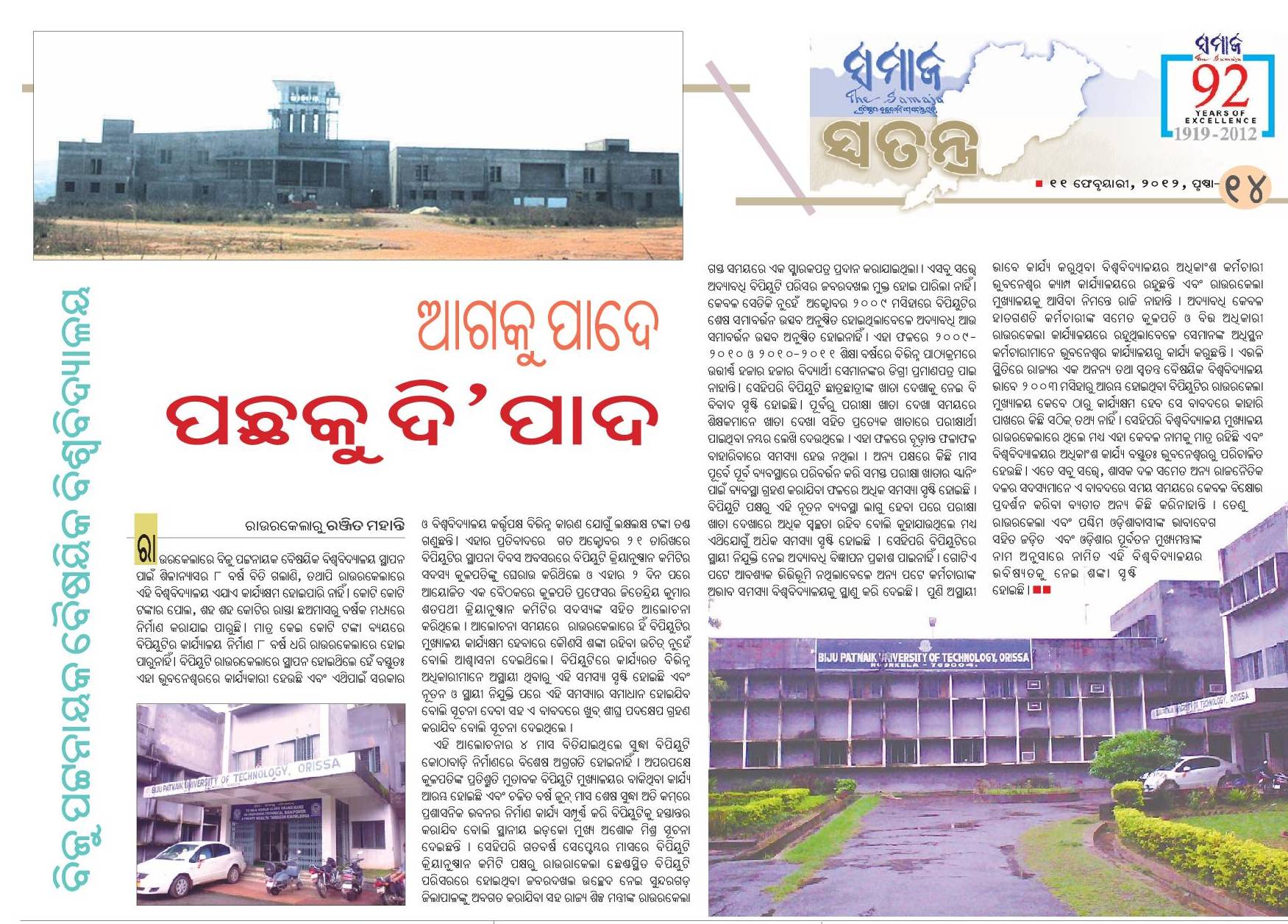
February 11th, 2012
While for reason of pride it is important that BPUT buildings get completed soon in Rourkela and BPUT becomes fully operational from Rourkela asap, what is most important for Rourkela in terms of higher education is a general university with programs in all disciplines: arts, commerce, sciences, engineering, pharmacy, etc. etc.
Rourkela is one of the few metropolitan areas of the country with a population greater than 500,000 that does not have a general university. There are a few other outliers such as Asansol and Dhanbad. (Dhanbad has ISMU; but its not a general university.) I would say if one checks the cities with more than 500 K population anywhere in the world, most would have a general university. In US, most cities with a population greater than 200K have a general university. In Odisha itself, much smaller cities and towns (Berhampur, Sambalpur, Balasore, Baripada and Koraput) have general universities.
As one can notice from recent news regarding Utkal University’s plan to have an engineering college (see also here), and before that about various new programs at Sambalpur university (see also here , here and here), once there is a general university, all kinds of disciplines, including engineering, can be added to it. One can go through the list of top universities and look at the various programs that are offered there. For Utkal see here and here. Moreover, these days while engineering seats are going empty (not in the government colleges though) there is a lot of demand for various general programs. See for example the number of applicants to various programs this year and last year at Utkal. The commerce program seems to have a very high demand and graduates of this program are doing well. Some numbers with respect to Sambalpur University are here.
Last year the higher education taskforce, among many other items, recommended a general university in Rourkela. However, I am not sure if any action is being taken based on that report. Regardless, I think the resurgent residents of Rourkela need to put the establishment of a general university in Rourkela among the top of their demands. I would put it at number one. The first thing that a city needs to become a real city is a general university. If people have to go out of town to pursue masters degree in regular disciplines like Economics or Commerce then the city is severely lacking.
November 28th, 2011


The 30.5 lakh sq feet is equivalent to 2,83,355.4066 sq meters and is equivalent to 70.0158 acres. As a comparison:
November 20th, 2011
Following is from a report in Telegraph by Priya Abarham.
The University Grant Commission (UGC) has sanctioned three new schools under the Central University of Orissa in Koraput.
These include School of Development Studies, School of Basic Sciences and Information Sciences and School of Biodiversity and Conservation of Natural Resources.
Following the sanction, three new courses have been started under each school from this academic year and admissions to these courses have begun.
The university has launched MSc in biodiversity and conservation of natural resources under School of Biodiversity and Conservation of Natural Resources in collaboration with the MS Swaminathan Research Foundation, Chennai.
Similarly, MA in economics has been launched under School of Development Studies and a five-year integrated course in mathematics has been launched under School of Basic Sciences and Information Sciences.
…Plans are afoot to start School of Health Sciences next year. “In response to a letter from the UGC, a detailed project report for the proposed medical college and hospital has already been submitted,” she said.
Three other MoUs have been signed with Jamia Hamdard University for collaborative programmes in nursing and community health, Narayan Hrudayalaya for courses in vocational development programmes in medical industry specific areas, and Public Health Foundation of India for collaboration in teaching and research for partnership under School of Health Sciences. The varsity is in also talks with the district hospital of Koraput for collaborative programmes in health sciences and allied programmes in the state.
Prior to this year the university had the following schools and courses.
| 1. School of Languages |
a) English (30 seats)
b) Oriya (30 seats) |
| 2. School of Social Sciences |
a) Anthropology & Tribal Studies (30 seats)
b) Sociology (30 seats)
c) Journalism and Mass Communication (30 seats) |
I appreciate the innovative strategy of the VC of getting help from reputed outside organizations for the new schools and new programs. Without that a young university in a backward and hinterland district and with a small faculty would not be able to provide quality education in the initial years.
If the university gets approval for a medical college next year then that would be a great achievement for the VC. We wish her and the university the best in that effort.
October 25th, 2011
Following is an excerpt from a report in Times of India.
… the debate over Pujari’s brainchild SU Institute of Information Technology (SUIIT) has divided faculty in the varsity and educationists in the region.
While a section of them term the less than two-year old institute as the biggest success story for the varsity, others dismiss it as the culprit ruining traditional departments.
…Sadhu Charan Panda, former VC of Utkal University of Culture and a former faculty member of SU said SUIIT is the best thing that has happened to the university and to Sambalpur region to be relevant with the changing time and technology. "In less than two years of its existence, it has already attracted state-wide attention," he said.
Panda cautioned that an institutional mechanism should be put in place so that SUIIT continues to excel.
Established in 2010 as an autonomous constituent of SU, the institute imparting MCA, BTech, MTech and MSc in computer science, MSc (electronics) and MSc (bioinformatics) has proved to be a sought after institute in the region. Students from the institutes have got lucrative paid summer internships while several software companies have shown interest to come for campus recruitments, sources said. "Such a thing was an unheard of possibility for the varsity a year ago," pointed out a varsity teacher.
While the state government had given an initial budget of Rs 10 crore in 2009-10 for the institute, Rs 5 crore from Directorate of Distance and Continuing Education (DDCE) was given to it for construction of its buildings inside the varsity.
Not all are convinced with the "rare success story" eulogy for SUIIT. "Most of the courses being offered by the SUIIT were pulled out from different existing departments. It was not a new thing," said Prof B K Tripathy, senior-most professor in the university.
Electronics was taken out of physics department, computer science from mathematics while bioinformatics was pulled out from life sciences department.
These courses were already offered by the varsity, Prof Tripathy said, adding whether the consolidation has done wonders will be known after the first batch comes out of SUIIT next year.
With the varsity administration concentrating solely on SUIIT, other departments were suffering, said a teacher, adding "the varsity is getting reduced to an engineering college." Some teachers and the students’ union have questioned the logic of starting B Tech in SU.
"Most engineering colleges are not getting students for B Tech and are on the verge of closure. The VSS University of Technology, three km away from SU, is offering such a course. There was no need to start it here," reasoned Karunakar Supkar, chancellor’s nominee in the Syndicate.
The students’ union has objected to undergraduate courses being offered in the varsity where all other courses are at the post-graduate level. "The varsity was exclusively for PG students. Starting an undergraduate course was diluting its character, which is unacceptable," said student union general secretary Asis Chand.
The people with the view in blue should checkout the top universities in the world and whether they have undergraduate programs or not.
In regards to the view in yellow, Prof. Karunakar Supkar should check the statistics of what percentage of students in VSSUT are from the Sambalpur area and what percentage of students in SUIIT are from the Sambalpur area. My guess is that there are very few Sambalpur area students in VSSUT while a much larger percentage of the students in SUIIT will be from the Sambalpur area.
In previous articles we have highlighted many of the achievements of Prof. Arun Pujari. If he is not allowed a second 3 year tenure at Sambalpur University, that would be a big loss for Sambalpur University and Sambalpur.
October 19th, 2011
Following is from http://www.bput.ac.in/bput_notice/1127recruitment_osme.html.
REGULAR RECRUITMENT TO CONSTITUENT COLLEGE
Applications in prescribed format along with details of qualification, experience and contribution to profession/ research are invited from Indian Nationals for the regular faculty positions (Professor, Asst. Professor and Lecturer) in Orissa School of Mining Engineering (Degree Stream), Keonjhar. The posts given below shall carry the revised pay and AGP as per notification of the 6th Pay issued by the Government of Orissa.
|
Branches
|
Professor
|
Asst. Professor
|
Lecturer
|
|
Electrical Engineering
|
1
|
1
|
2 (UR 1, ST 1)
|
|
Mechanical Engineering
|
1
|
1
|
2 (UR 1, ST 1)
|
|
Mining Engineering
|
1
|
1
|
3 (UR 1, ST 1 SEBC 1)
|
|
Electronics Engineering
|
0
|
1
|
1 (UR)
|
|
Computer Science & Engg
|
0
|
1
|
1 (UR)
|
|
Civil Engineering
|
0
|
0
|
1 (UR)
|
|
Mathematics
|
0
|
1
|
1 (UR)
|
|
Physics
|
0
|
0
|
1(UR)
|
|
Chemistry
|
0
|
0
|
1 (UR)
|
|
Geology
|
0
|
0
|
1 (UR)
|
|
Economics
|
0
|
0
|
1 (UR)
|
|
Management
|
0
|
0
|
1 (UR)
|
|
English
|
0
|
0
|
1 (UR)
|
* UR (Unreserved); ST (Scheduled Tribe) ; SEBC (Socially & Economically Backward classes )
* Qualification and experience for regular faculty positions: AICTE/ UGC norms would be applicable.
Application are invited in the prescribed format (format and other details are available in our website i.e.www.bput.ac.in) Applicants should enclose two passport size photographs and one A/c payee DD for Rs. 500/- (Rs.100/- for SC/ ST candidates) in favour of Biju Patnaik University of Technology, drawn on any Nationalized Bank, payable at Rourkela. The applicant is required to indicate the post applied for and submit separate application for each post. The applications would be accepted only by Post; No Hand Delivery is acceptable. In-service candidates would have to submit a ‘No Objection Certificate’ from the employers at the time of interview. The last date of receipt of application by the undersigned at BPUT, UGIE Complex, Jail Road, Rourkela -769004 is 20.09.2011. Minimum eligibility does not ensure that a candidate will be called for interview and be selected for any post; the decision of the authorities is final. For details please refer to the University website www.bput.ac.in.
 Click here to DOWNLOAD Application Form
Click here to DOWNLOAD Application Form
August 21st, 2011
Following is an excerpt from Shilpi Sampad’s report in Telegraph.
A university official said the sale of forms have soared this time as compared to previous years. Around 6,100 forms have already been sold at the two counters as against 7,000 last year. “We are expecting 2,000 more forms to come in. There has been an increase in sale of forms probably because more students are now opting for traditional and regular subjects,” the official said …
Following is an excerpt from a report in Times of India.
While there is just one applicant for statistics, which has 16 seats, there are very few aspirants for anthropology, food technology, bioinformatics electronics and home science.
Tripathy said there are very few colleges offering statistics at the graduation level. Hence, very few students want to pursue post-graduation in statistics. On the other hand, there are 66 applicants for 16 seats in MA or MSc mathematics.
The home science department this year has just four applicants for 16 seats. "This may be because the course had a new nomenclature this year. It was earlier called MA/MSc in home science. From this year, the varsity has changed it to MA/MSc home science (nutrition and human development) ," Tripathy said.
The varsity has got a record 250 applications for MSc Physics which has 24 seats. Some of these students will be given option to take admission in MSc electronics which has received around 10 applications for 20 seats.
The Sambalpur University Institute of Information Technology, which offers the bioinformatics and electronic courses, said students who have applied for MSc life sciences but failed to secure a seat will get a chance to take admission in MSc bioinformatics.
… Besides physics, departments of chemistry, English, sociology and political science also have received huge number of applications.
The varsity has got over 230 applications for 24 chemistry seats and 88 applications for 24 English seats. The varsity has got around 1800 applications this year for various PG courses compared to 1500 applications last session, varsity officials said.
June 29th, 2011
Earlier we mentioned the dynamism of the current Sambalpur University VC and some of the steps he has taken. This includes the establishment of SU-IIT (with B.Tech, M.Tech, MSc and MCA programs) and GOI funded Center for Food Science & Technology (offering an M.Tech). In addition to those, I got information regarding several additional new programs and centers. Those are:
- A 5-year integrated BBA+LLB program starting this July.
- Establishment of a School of Performing Arts with special thrust on Folk dance (Sambalpuri, Chhau, etc).
- A program on Insurance and Risk Management
I also came across the following ad in today’s paper.

In general, Prof. Arun Pujari, the current VC of Sambalpur University (on-lien from University of Hyderabad, where he has been a Professor in Computer Science as well as a Dean), has made significant contributions to Sambalpur University in his short tenure; much more than any Odisha VC I know of in recent years. Unfortunately his 3-yr tenure is coming to an end in November and already this year none of the 3 VCs (Utkal U, Fakir Mohan U, and NOU) were reappointed.
I hope the Odisha Governor makes an exception and reappoints Prof. Pujari for another 3 year term so that he can stablize the various programs and centers that he initiated and established.
If that happens there is a high chance that the best two universities of Odisha will be in Sambalpur: VSSUT and Sambalpur University.
May 26th, 2011
It now has its own website at http://suiit.ac.in/. Following is the ad that appeared in various newspapers.
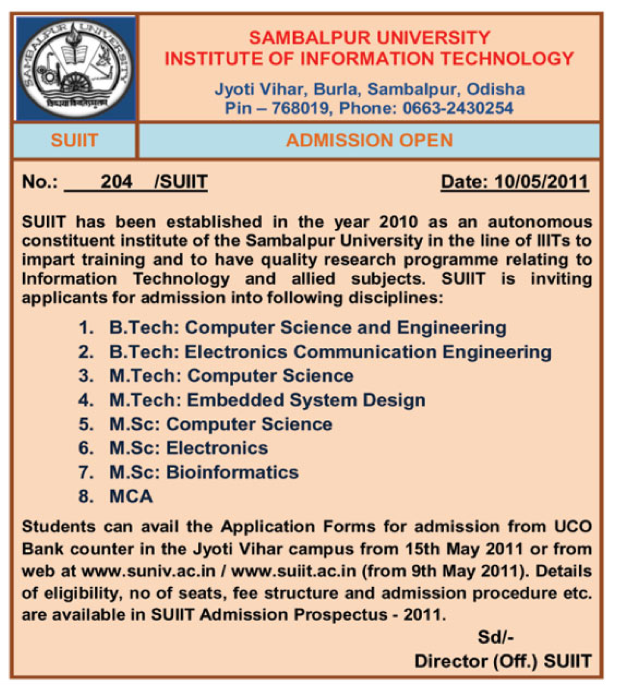
Following is a screen copy of the web page of SUIIT.
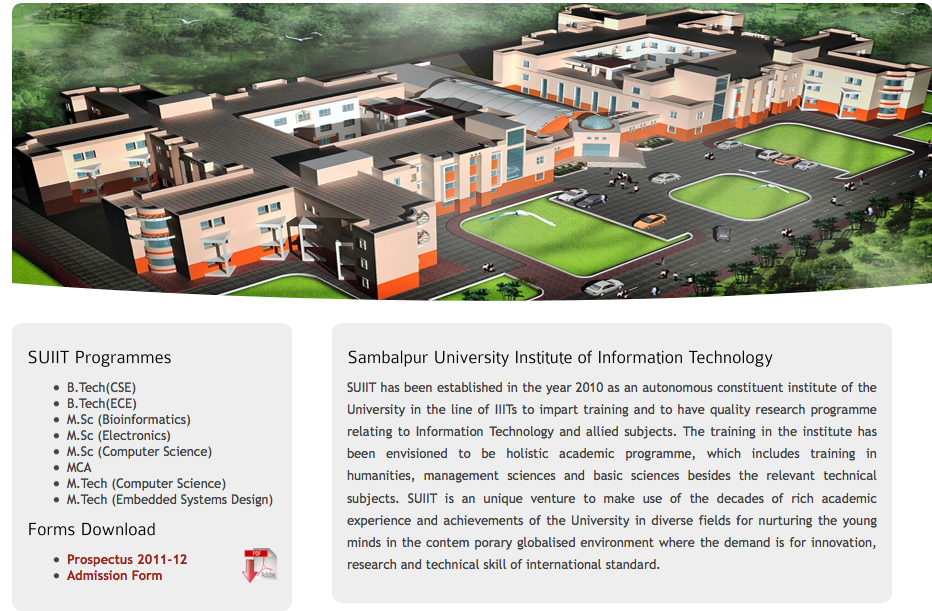
With the new B.Tech programs, Sambalpur University will become the first general university of Odisha to offer such a program. Kudos to its VC for his vision and this unique achievement.
May 13th, 2011
The newsletter is at http://www.centraluniversityorissa.ac.in/Downloads/Newsletter_Feb.%202011.pdf.
Page 9: From the Vice-Chancellor’s statement:
From the forthcoming academic session the University proposes to introduce five new subjects under New Schools …
As for the progress of our physical infrastructure of the main campus, the construction of the Boundary Wall is almost through and the construction of buildings in the first phase, the Girls’ Hostel, the Boys’ Hostel, the Guest House and the Academic Block I are likely to start towards the end of March.
… As a Founding Vice-Chancellor my vision of this composite University has two well-defined thrust areas in terms of priorities: One is healthcare and subsequently the introduction / dissemination of medical education and the other is related to the development and welfare of the tribal community.
Page 12: Development of Campus (progress of the Boundary Wall)
The main campus of our University is coming up at Sunabeda. The construction of boundary wall undertaken by CPWD is in progress. Out of actual 9.3 kms of boundary wall about 8.6 kms work is completed. The pillar excavation, raising columns on rocky terrains of the boundary is almost over. The brickwork and plastering of the Boundary Wall is going on in full swing.
The master plan has also been approved by the University Building Committee. Recently the Chief Engineer of CPWD has visited our main campus in Koraput and inspected the progress of construction work.
Page 24: The List of forthcoming Centres and Schools of the Central University of Orissa duly approved by the Academic Council and the Executive Council
The Academic Council and the Executive Council of CUO have approved the establishment of the following new Schools and Centres:

Page 31: Centre for Tribal Welfare and Community Development
Extreme poverty has its own typical features and adverse impacts on any society. Migration in search of survival for livelihoods is gradually becoming a common phenomenon in the KBK region as well as in the other parts of the country. For the survival of local people, the traditional skill based occupations are gradually becoming uneconomic options. On the other hand the same traditional skills have a flourishing market value in neighbouring states. This creates situations for mass migration, often with the family, in search of a livelihood even under stressful conditions. In the recent trend of economic development, the traditional skill based occupations have also became largely resource dependent. With the depletion of natural resources, the traditional occupations of tribes are fading away, though these are also the outcome of the occupational mobility.
The Koraput District comes under the tribal sub-plan area and PESA. As per the provision, PESA promises devolution of power to Panchayats completing the tribal self-rule. While larger accountability for the utilizing the provisions under the Act is vested in the Panchayats, due to poor understanding of the Act by the Panchayatiraj functionaries the Act seems to have lost its legal tooth in this area. This calls for wider accountability of government and civil society bodies to build the capacity of the PRIs thereby enabling them to utilize the power and authority vested in them for the development of their area and the communities. The customary rules existing even today provide a framework to compare the provisions of PESA and a suitable blending of two can contribute towards good governance to spearhead developmental process.
According to the report of the Committee on the Constitution of Separate Development Board in Orissa, 96% of Community Development Blocks in KBK districts are either ‘very backward’ or ‘backward’. According to the UNDP Human Development Report 2004, Malkangiri, Kandhamal, Gajapati, Koraput, Nabarangpur are the bottom five districts in terms of HDI values, three of which are in KBK region.
Considering the above issues, the Centre for Tribal Welfare and Community Development (CTWCD) has been established as University’s first initiative of Corporate Social Responsibilities to foster the needs and take up the issues of the tribals of KBK region as well as other tribal groups of India.
The Centre for Tribal Welfare and Community Development at Central University of Orissa is functional since 5th June,2010. A batch of tribal youth has already received training on mushrooms cultivation. New initiatives are under progress and it is hoped that various trade identified by the Centre will benefit the tribes.
Page 47: Progress of new Campus


April 27th, 2011
Update on April 9th 2011: Here is the ad from today’s Samaja. The detailed ad is at http://www.vssut.ac.in/Faculty-2011.pdf. They list 23 Professor positions + 57 Reader positions and 50 lecturer positions. The minimum qualification for professors and readers is a Ph.D and among lecturers, at least in science and humanities, most that will be hired will have Ph.Ds. Once these positions are filled it will increase the number of Ph.D faculty in VSSUT by at least 90.

Following is from a mail sent by Prof. Rakesh Mohanty of VSSUT Burla. It also appears in the alumni site at http://vssut.org/uncategorized/history-created-by-honorable-vc-vssut-burla/.
You will be thrilled and suprised to know that under the dynamic leadership and painstaking effort of Honorable Vice-chancellor, VSSUT Burla, Govt of Orissa has sanctioned 96 New Regular faculty positions (Professors, Readers and Lecturers) for VSSUT Burla.
A great achievement for VSSUT Burla.
This is really wonderful news. If they are able to hire good people against these positions VSSUT will be one of the top technical university in the country and will be next in line for upgradation to an IIEST.
In 2006 the then UCE Burla had submitted a proposal for becoming an IIEST. At that time it had 97 positions sanctioned but with 62 faculty out of which 36 had Ph.D.
I am not sure of the current situation, but with 96 new positions, the sanctioned strength will at least become 193, which is a good number to make a claim for an IIEST.
As per a document prepared by the then UCE Burla in 2006, the then faculty strength of the colleges that were earlier shortlisted for becoming IIEST were as follows:
- IT BHU: 229 faculty with 170 having PhD
- UCET-Osmania U: 127 faculty with 57 having Ph.D
- BESU: 212 faculty with 136 having Ph.D
- UCE-Andhra U: 123 faculty with 68 having Ph.D
- CUSAT: 206 faculty with 151 having Ph.D
So VSSUT’s claim for an IIEST will now depend on how quickly and how many Ph.D faculty they can hire. The sanctioned strength of 193 is pretty good.
Note that earlier in March 2011 VSSUT had advertised for 34 positions (23 lecturers+ 9 readers + 2 professors). See http://www.vssut.ac.in/adv_20111.pdf.
April 9th, 2011
The following is from http://www.centraluniversityorissa.ac.in/Faculty_Details.asp?pgid=4 with the information in blue added via web searching.
| 1. Dr. Kanhu Charan Satapathy (Centre for Anthropological Studies) Ph.D in Anthropology, 2007, Utkal University. Previously faculty at SM Govt. Women’s College, Phulbani. Successfully completed the UGC Refresher Course training program in Anthropology at UGC Academic Staff College, Utkal University, Bhubaneswar, Orissa. Published a book on "Refugees’ Health" by Athena Books, 2010. Presented a research paper entitled ‘Tibetans in India and Their Coping Strategies from a Bio-Cultural Perspective" at the National Seminar on Bio-Cultural Anthropology: Prospects and Challenges, organized by Post-Graduate Department of Anthropology, Utkal University, Bhubaneswar in Collaboration with Anthropological Survey of India, Kolkata from 27-28 March, 2010. |
|

|
| 2. Dr. Meera Swain (Centre for Anthropological Studies) Previously faculty at NISWASS Bhubaneswar. Presented a research paper entitled "Social Responsibility, Awareness and Participation of Local Communities in Conserving the Coastal Environment: A Study in Orissa, East Coast of India" at the National Seminar on Bio-Cultural Anthropology: Prospects and Challenges, organized by Post-Graduate Department of Anthropology, Utkal University, Bhubaneswar in Collaboration with Anthropological Survey of India, Kolkata from 27-28 March, 2010. |
|

|
| 3. Dr. Debendra Biswal (Centre for Anthropological Studies) Ph.D in Anthropology, Delhi University. Thesis title: Ecology and Health : A Comparative Study of Kutia Kondhs and Gonds in Orrisa. Presented a research paper entitled “Ecosystem approach in health: Is it holistic or partial?” at the National Seminar on Bio-Cultural Anthropology: Prospects and Challenges, organized by Post-Graduate Department of Anthropology, Utkal University, Bhubaneswar in Collaboration with Anthropological Survey of India, Kolkatafrom 27-28 March, 2010. |
|

|
| 4. Dr. Kailash Bantha (Centre of Odia Language & Literature) Publication of D Litt.Thesis titled "Fakir Mohanka Katha Sahitya re Karma Fala". Edited "Ratnakar Chaininka Charoti Chhoto Natak and Amurta Manara Murta Bhaskar". Publication of Ph.D thesis titled "Oriya Upanyasre Shaitan Charitra". Felicitation by "Dakhin Orissa Sanskrutik Sansad, Malkangiri". |
|

|
| 5. Dr. Rudrani Mohanty (Centre of Odia Language & Literature) Words fail to express my heartfelt feelings when I boarded Hirakhand Express to join as a faculty in the noscent Central University at the bosom of nature in Koraput. Lush green hills, the beautiful bounties of nature, the offectionate studentant teacher relationship in campus added a lively chapter in my life under the caring and guiding umbrella of our dynamic University authority. It makes my life poetic as well as practical and engrossing. |
|

|
| 6. Dr. Ganesh Prased Sahu (Centre of Odia Language & Literature) The Central University of Orissa, Koraput has created educational revolution in Orissa. Basically the Tribal Students of southern Orissa will be involved in that progress. The University has focused on Humanities Study like School of Languages (Oriya & English) and School of Social Sciences (Anthropology & Sociology). The students are really lucky as the first batch of this University. They are keenly interested to attend class programmes at Koraput and try to prove their potentialities through examinations. Being a lecturer I always trying to inculcate inclinations of subjects with deep root of knowledge to my students. Every part towards development of this University is going on smoothly with a proper guidance and good ideology. I wish all betterment and a prosperous future to this new Central University. |
|

|
| 7. Dr. Kapila Khemundu (Centre for Sociology Studies), Ph.D in 2008-09 from JNU. Thesis: Indian Sociology and its Engagement with Values: A Comparative Study of Select Discourses. It is encouraging that the newly established Journalism and Mass Communication, Anthropology, Sociology, Oriya and English Departments in the Central University of Orissa, Koraput are shaping up under the dynamic leadership of University authority along with newly recruited young energetic faculty. Their commitment towards teaching and learning activities is positive indication to establish a vibrant academic tradition to achieve the aims and objectives of the higher education in the country. I firmly believe despite having its location in remote area this university will be recognized in near future as a centre for excellence in education. |
|

|
| 8. Aditya K. Mishra has joined as a Lecturer in the Centre for Sociological Studies on 8th February, 2010. He has done his M.A., M.Phil & Ph.D (TBA) from the prestigious University of Hyderabad. He has published various research papers and reviews in leading peer-reviewed journals. He has also presented several research papers in national and international conferences. His research interests include Sociology of Development, Sociology of Health, Environmental Sociology and Contemporary Socio Economic issues. He can be reached at adityamishra80@gmail.com
Presented a research paper (co-authored by Prof. E. Haribabu [University of Hyderabad]) entitled ‘Interrogating Participatory Biodiversity Conservation: Social Capital, CBCDCs and Conservation Outcomes’ at the National Seminar on Bio-Cultural Anthropology: Prospects and Challenges, organized by Post-Graduate Department of Anthropology, Utkal University, Bhubaneswar in Collaboration with Anthropological Survey of India, Kolkata from 27-28 March, 2010.
|
|

|
| 9. Sujit Kumar Mohanty has joined as a Lecturer in the Centre for Media Studies on 8th February, 2010. He has done his M.A. (Communication) from the prestigious University of Hyderabad. He is currently pursuing his M. Phil in the Centre for Regional Studies, University of Hyderabad. He was worked with a leading English newspaper of the Southern India – Deccan Chronicle and also undertaken a project with UNICEF. He was also associated with CNN – IBN (New Delhi) for a short while and then moved to TV9 – English as an assignment editor. His research interests include Media and Development, Film Studies & Religion and Politics in Media. He can be reached at sujitadm@gmail.com |
|

|
| 10. Talat Jahan Begum has joined as a Lecturer in the Centre for Media Studies on 8th February, 2010. She has done her M.A in Journalism and Mass Communication from Utkal University. With a teaching experience of 20 years, she has taught Journalism and Mass Communication at the prestigious BJB Autonomous College at Bhubaneswar. She was worked as Project Coordinator for UNICEF sponsored Project on "Children Reporting Children Issues". She has participated in International Visitor Leadership Program on "Community Approaches to Social Issues" in USA in 2008. She has also worked with ETV. She is actively involved with the NSS. Her research interests include Mass Communication Research, Community Media &TV Journalism. She can be reached at talattjb@yahoo.co.in |
|

|
| 11. Sony Parhi (Centre for Journalism and Mass Communication Studies) The Central University of Orissa, Koraput is the outcome of long cherished dreams. Hard work, initiative, collaboration and readiness to face challenges are hallmarks of Journalism and Mass Communication faculty and students. The remoteness of the place and challenges in communicating effectively with a varied audience give ample avenues to our entire team. Rich cultural heritage of this region and the task of disseminating the same through agencies of mass media for holistic progress is our goal. This University also teaches me to pursue knowledge and research while maintaining empathy and harmony towards my environment. |
|

|
| 12. Sanjeet Kumar Das (Centre of English) Having joined in the Department of English, Central University of Orissa, Koraput, I am overwhelmed to disseminate my experiences to young and energetic students in the field of language and literature. The leitmotif of our ‘School of Languages’ is to import education and research in new vistas such as Women writings in the Post modern era, Ecocriticism, literature on Diaspora writings etc. In the domain of linguistics, we focus our research on applied areas such as Computational linguistics, Evolutionary linguistics, Biolinguistics, Cognitive linguistics, Neuro-linguistics, Ethno linguistics, and Geolinguistics etc. Nevertheless, theoretical linguistics like Phonology and phonetics, morphology, syntax, semantics and pragmatics are also emphasized for the development of communicative competence among the students. I am pursuing my Ph. D in the Department of Humanities & Social Sciences, IIT Kanpur. |
|

|
| 13. Himani Mishra (Centre for Sociology Studies) The Central University of Orissa, Koraput is now in the stage of infancy and has a long way to go ahead. Still it is constructing the good architects for our future and one day it will definitely achieve this goal where it will be among the best Universities giving proper shapes to the students. Being a part of this newly built institute, I feel glad. |
|

|
March 8th, 2011
Previous Posts




